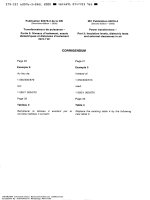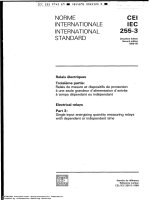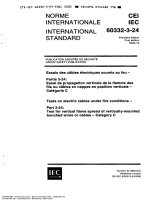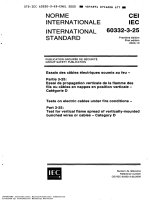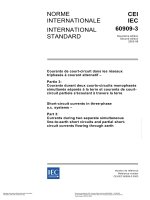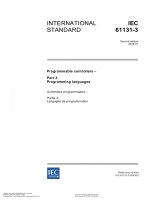Iec 60746 3 2002
Bạn đang xem bản rút gọn của tài liệu. Xem và tải ngay bản đầy đủ của tài liệu tại đây (383.32 KB, 24 trang )
INTERNATIONAL
STANDARD
IEC
60746-3
Second edition
2002-06
Expression of performance of
electrochemical analyzers –
Part 3:
Electrolytic conductivity
Expression des qualités de fonctionnement
des analyseurs électrochimiques –
Partie 3:
Conductivité électrolytique
Reference number
IEC 60746-3:2002(E)
--`,,```,,,,````-`-`,,`,,`,`,,`---
Copyright International Electrotechnical Commission
Provided by IHS under license with IEC
No reproduction or networking permitted without license from IHS
Not for Resale
Publication numbering
As from 1 January 1997 all IEC publications are issued with a designation in the
60000 series. For example, IEC 34-1 is now referred to as IEC 60034-1.
Consolidated editions
The IEC is now publishing consolidated versions of its publications. For example,
edition numbers 1.0, 1.1 and 1.2 refer, respectively, to the base publication, the
base publication incorporating amendment 1 and the base publication incorporating
amendments 1 and 2.
Further information on IEC publications
•
IEC Web Site (www.iec.ch)
•
Catalogue of IEC publications
The on-line catalogue on the IEC web site (www.iec.ch/catlg-e.htm) enables
you to search by a variety of criteria including text searches, technical
committees and date of publication. On-line information is also available on
recently issued publications, withdrawn and replaced publications, as well as
corrigenda.
•
IEC Just Published
This summary of recently issued publications (www.iec.ch/JP.htm) is also
available by email. Please contact the Customer Service Centre (see below) for
further information.
•
Customer Service Centre
If you have any questions regarding this publication or need further assistance,
please contact the Customer Service Centre:
Email:
Tel:
+41 22 919 02 11
Fax: +41 22 919 03 00
Copyright International Electrotechnical Commission
Provided by IHS under license with IEC
No reproduction or networking permitted without license from IHS
Not for Resale
--`,,```,,,,````-`-`,,`,,`,`,,`---
The technical content of IEC publications is kept under constant review by the IEC,
thus ensuring that the content reflects current technology. Information relating to
this publication, including its validity, is available in the IEC Catalogue of
publications (see below) in addition to new editions, amendments and corrigenda.
Information on the subjects under consideration and work in progress undertaken
by the technical committee which has prepared this publication, as well as the list
of publications issued, is also available from the following:
INTERNATIONAL
STANDARD
IEC
60746-3
Second edition
2002-06
--`,,```,,,,````-`-`,,`,,`,`,,`---
Expression of performance of
electrochemical analyzers –
Part 3:
Electrolytic conductivity
Expression des qualités de fonctionnement
des analyseurs électrochimiques –
Partie 3:
Conductivité électrolytique
IEC 2002 Copyright - all rights reserved
No part of this publication may be reproduced or utilized in any form or by any means, electronic or
mechanical, including photocopying and microfilm, without permission in writing from the publisher.
International Electrotechnical Commission, 3, rue de Varembé, PO Box 131, CH-1211 Geneva 20, Switzerland
Telephone: +41 22 919 02 11 Telefax: +41 22 919 03 00 E-mail: Web: www.iec.ch
Commission Electrotechnique Internationale
International Electrotechnical Commission
Международная Электротехническая Комиссия
Copyright International Electrotechnical Commission
Provided by IHS under license with IEC
No reproduction or networking permitted without license from IHS
Not for Resale
PRICE CODE
For price, see current catalogue
J
–2–
60746-3 IEC:2002(E)
CONTENTS
FOREWORD...........................................................................................................................3
1
Scope ...............................................................................................................................5
2
Normative references .......................................................................................................5
3
Definitions ........................................................................................................................5
4
Procedure for specification ...............................................................................................8
5
6
4.1 Additional statements on sensor units .....................................................................8
4.2 Additional statements on electronic units .................................................................8
4.3 Additional statements on complete analyzers ..........................................................8
Recommended standard values and ranges of influence quantities affecting the
performance of electronic units.........................................................................................8
Verification of values ........................................................................................................8
6.1
6.2
6.3
6.4
General aspects ......................................................................................................9
Calibration...............................................................................................................9
Test solutions ..........................................................................................................9
Test procedures .................................................................................................... 10
Annex A (informative) Electrolytic conductivity values of potassium chloride calibration
solutions and pure water ....................................................................................................... 12
Annex B (informative) Electrolytic conductivity values of aqueous sodium chloride
solutions ............................................................................................................................... 13
Annex C (normative) Alternative procedures for measuring response times: delay
(T 10 ), rise (fall) (T r , T f ) and 90 % (T 90 ) times ....................................................................... 15
Annex D (informative) Conductivity cells ............................................................................... 16
Bibliography.......................................................................................................................... 17
Table A.1 – Electrolytic conductivity values........................................................................... 12
Table A.2 – Electrolytic conductivity of pure water ................................................................ 12
Table B.1 – Conductivity of sodium chloride solutions at 18 °C ............................................. 13
Table B.2 – Temperature coefficients for low-concentration sodium chloride solutions .......... 14
--`,,```,,,,````-`-`,,`,,`,`,,`---
Table B.3 – Tentative corrections to sodium chloride solution temperature coefficients ......... 14
Copyright International Electrotechnical Commission
Provided by IHS under license with IEC
No reproduction or networking permitted without license from IHS
Not for Resale
60746-3 IEC:2002(E)
–3–
INTERNATIONAL ELECTROTECHNICAL COMMISSION
____________
EXPRESSION OF PERFORMANCE
OF ELECTROCHEMICAL ANALYZERS –
Part 3: Electrolytic conductivity
FOREWORD
1) The IEC (International Electrotechnical Commission) is a worldwide organization for standardization comprising
all national electrotechnical committees (IEC National Committees). The object of the IEC is to promote
international co-operation on all questions concerning standardization in the electrical and electronic fields. To
this end and in addition to other activities, the IEC publishes International Standards. Their preparation is
entrusted to technical committees; any IEC National Committee interested in the subject dealt with may
participate in this preparatory work. International, governmental and non-governmental organizations liaising
with the IEC also participate in this preparation. The IEC collaborates closely with the International
Organization for Standardization (ISO) in accordance with conditions determined by agreement between the
two organizations.
2) The formal decisions or agreements of the IEC on technical matters express, as nearly as possible, an
international consensus of opinion on the relevant subjects since each technical committee has representation
from all interested National Committees.
3) The documents produced have the form of recommendations for international use and are published in the form
of standards, technical specifications, technical reports or guides and they are accepted by the National
Committees in that sense.
4) In order to promote international unification, IEC National Committees undertake to apply IEC International
Standards transparently to the maximum extent possible in their national and regional standards. Any
divergence between the IEC Standard and the corresponding national or regional standard shall be clearly
indicated in the latter.
5) The IEC provides no marking procedure to indicate its approval and cannot be rendered responsible for any
equipment declared to be in conformity with one of its standards.
6) Attention is drawn to the possibility that some of the elements of this International Standard may be the subject
of patent rights. The IEC shall not be held responsible for identifying any or all such patent rights.
International Standard IEC 60746-3 has been prepared by subcommittee 65D: Analyzing
equipment, of IEC technical committee 65: Industrial-process measurement and control.
This second edition cancels and replaces the first edition, published in 1985, and constitutes
a technical revision.
This standard shall be used in conjunction with IEC 60746-1.
The text of this standard is based on the following documents:
FDIS
Report on voting
65D/85/FDIS
65D/87/RVD
Full information on the voting for the approval of this standard can be found in the report on
voting indicated in the above table.
This publication has been drafted in accordance with the ISO/IEC Directives, Part 3.
Annex C forms an integral part of this standard.
Annexes A, B and D are for information only.
--`,,```,,,,````-`-`,,`,,`,`,,`---
Copyright International Electrotechnical Commission
Provided by IHS under license with IEC
No reproduction or networking permitted without license from IHS
Not for Resale
–4–
60746-3 IEC:2002(E)
IEC 60746 consists of the following parts, under the general title Expression of performance
of electrochemical analyzers:
Part 1: General
Part 2: pH value
Part 3: Electrolytic conductivity
Part 4: Dissolved oxygen in water measured by membrane covered amperometric sensors
Part 5: Oxidation-reduction potential or redox potential
Part 6: Conductivity effect of foreign ions in ultrapure waters, from combined conductivity and pH1)
The committee has decided that the contents of this publication will remain unchanged until
2007. At this date, the publication will be
•
•
•
•
reconfirmed;
withdrawn;
replaced by a revised edition, or
amended.
A bilingual version of this publication may be issued at a later date.
________
1)
Under consideration.
--`,,```,,,,````-`-`,,`,,`,`,,`---
Copyright International Electrotechnical Commission
Provided by IHS under license with IEC
No reproduction or networking permitted without license from IHS
Not for Resale
60746-3 IEC:2002(E)
–5–
EXPRESSION OF PERFORMANCE
OF ELECTROCHEMICAL ANALYZERS –
Part 3: Electrolytic conductivity
1
Scope
This part of IEC 60746 is intended
–
to specify terminology, definitions and requirements for statements by manufacturers for
analyzers, sensor units, and electronic units used for the determination of the electrolytic
conductivity of aqueous solutions;
–
to establish performance tests for such analyzers, sensor units and electronic units;
–
to provide basic documents to support the applications of quality assurance standards
ISO 9001 [1] 1) , ISO 9002 [2] and ISO 9003 [3].
2
Normative references
The following referenced documents are indispensable for the application of this document.
For dated references, only the edition cited applies. For undated references, the latest edition
of the referenced document (including any amendments) applies.
IEC 60746-1, Expression of performance of electrochemical analyzers – Part 1: General
3
Definitions
For the purpose of this part of IEC 60746, the definitions of IEC 60746-1 apply, together with
the following definitions.
3.1
electrolytic conductance
current divided by the potential difference in the case of ionic charge transport within an
electrolytic solution filling a conductivity cell:
G =
I
U
where
I
is the current through the electrolyte, in amperes (A);
U is the potential difference applied across the electrodes, in volts (V);
G is the electrolytic conductance, in siemens (S).
Electrolytic resistance is the reciprocal of electrolytic conductance with the ohm (Ω) as the
unit of measurement
________
1)
Figures in square brackets refer to the bibliography.
--`,,```,,,,````-`-`,,`,,`,`,,`---
Copyright International Electrotechnical Commission
Provided by IHS under license with IEC
No reproduction or networking permitted without license from IHS
Not for Resale
60746-3 IEC:2002(E)
–6–
--`,,```,,,,````-`-`,,`,,`,`,,`---
3.2
electrolytic conductivity
formerly called specific conductance, is defined by the equation:
κ =
j
E
where
j
is the electric current density, in A⋅m –2 ;
E
is the electric field strength, in V⋅m –1 .
The unit of electrolytic conductivity, κ, is siemens per metre (S⋅m –1 ). Electrolytic resistivity is
the reciprocal of electrolytic conductivity with the unit of ohmmeter (Ω⋅m)
NOTE In practical use, the most commonly employed conductivity unit is microsiemens per centimetre (µS⋅cm –1 )
or the corresponding resistivity unit, megohm per centimetre (MΩ . cm)
1 µS⋅cm –1 = 10 –4 S⋅m –1
3.3
cell constant of the sensor unit
an electrolytic conductor of a uniform cross-section X and length L is defined by the equation:
κ cell =
L
X
where K cell is the cell constant, in m –1 (see Note 1).
It is usual to measure electrolytic conductivity by means of cells without a uniform crosssection, in which case the K cell should be determined by means of a reference solution of
known electrolytic conductivity.
The relationship between electrolytic conductance and electrolytic conductivity is defined by
the equation:
κ = Kcell × G
where
κ
is the electrolytic conductivity, in S⋅m –1 ;
G
is the electrolytic conductance, in S;
K cell is the cell constant, in m –1 .
NOTE 1
In practical use, K cell is generally expressed in cm –1 ,
κ in µS⋅cm –1 and G in µS
(see 3.2).
NOTE 2 The cell constant will normally have a constant value over a stated range (see 4.1). Outside this range, it
should be expected that polarization or other effects will produce errors (see 3.4 and annex D).
3.4
polarization
effect which occurs at electrode surfaces in an electrolytic solution when the current between
the electrodes is such as to produce electrolysis and consequent partial insulation of the
electrode surface
To avoid this uncertainty, different measuring methods can be applied (see 3.7, 3.8 and
annex D):
a) a.c. measurements with a frequency high enough to avoid polarization effects;
b) four or six electrode measurements with separated current transporting and potential
measuring electrodes;
c) inductive or capacitive measurements by coupling between the electrolytic conductor and
the electrical measuring circuit through non-conductive media.
Copyright International Electrotechnical Commission
Provided by IHS under license with IEC
No reproduction or networking permitted without license from IHS
Not for Resale
60746-3 IEC:2002(E)
–7–
In each case, the relationship between the electrolytic conductivity and the measured output
quantity is established by the cell constant.
3.5
temperature coefficient
relative increase (or decrease) of the electrolytic conductivity of a solution per kelvin
temperature change. The temperature coefficient is dependent on the reference temperature
and the nature of the solution.
The following approximate equation can be applied for strong electrolyte solutions where
κ > 10 –4 S⋅m –1 (1 µS⋅cm –1 )
κ t = κ tr × (1 + α∆t )
where
κt
is the electrolytic conductivity at temperature t;
κtr
is the electrolytic conductivity at reference temperature tr;
∆t
is the temperature difference t − tr;
α
is the temperature coefficient.
In practice, this formula is sufficiently accurate over a small temperature range. For large
temperature ranges, it is usually necessary to add higher terms of a polynomial series (such
as β (∆t) 2 + γ (∆t) 3 +....) to the above equation, to obtain sufficient accuracy. The percentage
temperature coefficient, which is the percentage relative deviation per kelvin from the
reference value κtr , is often used so that
α (%) = 100 α
NOTE The manufacturer’s literature should be consulted for details of sample temperature compensation
technique(s) applied.
3.6
simulator
a series of non-inductive resistors (preferably step-variable, e.g., a decade resistance box),
used for the performance tests of conductimetric electronic units, simulating two- and threeelectrode sensors
NOTE The minimum step should preferably be 0,01 R, where R is the reciprocal value of the nominal full range
conductivity value. Analogously, the highest resistance value should correspond to the lower limit of the measuring
range: if the range begins at zero, the resistance value should be at least 10 R for testing at 10 % of the range.
For multi-electrode sensor simulator design, the manufacturer must be consulted.
The temperature sensor may be simulated by another variable precision resistor, e.g., a
variable decade resistance box.
3.7
cell capacitance
produced by the electrostatic field existing between the sensor's measuring electrodes due to
the high dielectric constant of water. Its value is inversely proportional to the cell constant and
expressed by the approximate relationship:
C cell Ω
7
K cell
where
C cell
is the cell capacitance, in picofarads (pF: 1 pF = 10 –12 F);
K cell
is the cell constant, in cm –1;
C cell
may disturb low conductivity measurements made with two- or three-electrode cells
when too high a frequency is used. The effect can be reduced by means of phase
discrimination within the electronic unit.
--`,,```,,,,````-`-`,,`,,`,`,,`---
Copyright International Electrotechnical Commission
Provided by IHS under license with IEC
No reproduction or networking permitted without license from IHS
Not for Resale
–8–
60746-3 IEC:2002(E)
--`,,```,,,,````-`-`,,`,,`,`,,`---
3.8
leakage currents
a.c. currents at the measuring frequency flowing from the cell electrodes to local conductive
parts in contact with the sample solution.
They effectively alter the cell constant causing measuring uncertainties and arise principally in
symmetrical cells, i.e., with similar electrodes side by side.
4
Procedure for specification
See clause 5 of IEC 60746-1, plus the following.
4.1
Additional statements on sensor units
a) Type, i.e., flow-through, dip or insertion unit, number of electrodes, if electrodeless
whether inductive or capacitive cell (common types of cell are described in annex D).
b) Cell constant, tolerance and corresponding range of measurement (see 4.3a)).
c) Type of temperature compensator (for example, Pt100).
d) Sensor dimensions, mounting and connection details.
4.2
Additional statements on electronic units
a) Measuring frequency/frequencies.
b) Cell constant adjustment range.
c) Type of temperature compensator sensor to which the electronic unit can be connected
and maximum permitted resistance of compensator plus connection leads.
d) Reference temperature adjustment range; if fixed, state temperature.
e) Range of temperature coefficient adjustment and details of sample temperature
compensation that may be applied. If fixed, state value.
f)
4.3
Installation details.
Additional statements on complete analyzers
a) Measuring ranges (rated and effective).
NOTE Some analyzers employ concentration units, for example, mass % NaCl, g NaOH per litre, etc.
For such analyzers, the rated range should be specified on the measurement unit as well as the corresponding
conductivity at the rated reference temperature.
b) Reference temperature for the measurement.
c) Installation details.
5
Recommended standard values and ranges of influence quantities
affecting the performance of electronic units
See annex A of IEC 60746-1.
6
Verification of values
See clause 6 of IEC 60746-1
Copyright International Electrotechnical Commission
Provided by IHS under license with IEC
No reproduction or networking permitted without license from IHS
Not for Resale
60746-3 IEC:2002(E)
6.1
–9–
General aspects
The parameters required to be set in the electronic unit for the specific combination of the
electronic unit and sensor shall be established. These shall include
–
the range to be measured and the units for display (if a display is fitted);
–
the range and type of any transmitted output;
–
the type of sample, i.e., a flow-through sample and its flow rate, or a static sample into
which the sensor is immersed and its minimum depth;
–
the type and range of sample temperature compensation for which verification is required,
if applicable.
6.2
Calibration
For accurate calibration of a conductivity analyzer the following parameters are required for
adjustment on the electronic unit:
a) the cell constant (see 3.3 and 4.2 b));
b) the reference temperature (see 4.2d));
c) the temperature coefficient or appropriate algorithm (see 4.2e)).
NOTE The exact value of the cell constant can be determined using an appropriate calibration solution (see
annex A).
6.3
Test solutions
Test solutions shall be applied in a manner suited to the design of the sensor.
For flow-through sensors, the solutions shall be applied at a flow rate within the manufacturer’s stated rated range.
For sensors which can be immersed into test solutions, it is essential that the sensor unit is
rinsed several times with water of negligible conductivity (in comparison with the range to be
tested) after immersion in one solution prior to immersion in a fresh solution. A good
procedure is to keep a second container of each test solution concentration to be used for the
final rinse prior to immersion in each respective accurate test solution.
The immersion of sensor probes into containers of test solution exposed to air is not
appropriate for measurements below 100 µS⋅m –1 .
NOTE De-ionized water in an open container absorbs CO 2 ; a typical equilibrium conductivity of approximately
0,9 µS⋅cm –1 is eventually reached.
Examples of test solutions are tabulated in annex B.
For low-conductivity solutions below about 100 µS⋅cm –1 (at 25 °C), it is essential that flowing
solutions of appropriate conductivities are generated by continuous injection of, e.g., NaCl
solutions into a pure water stream at a controlled flow rate. Required concentrations may be
determined by extrapolation of values in annex B.
Pure water can only be generated by a circulatory de-ionization system: standard test
solutions shall be generated from such water.
--`,,```,,,,````-`-`,,`,,`,`,,`---
Copyright International Electrotechnical Commission
Provided by IHS under license with IEC
No reproduction or networking permitted without license from IHS
Not for Resale
– 10 –
6.4
60746-3 IEC:2002(E)
Test procedures
The following test procedures shall be carried out as described in IEC 60746-1, using the
appropriate test solutions.
a) Intrinsic uncertainty
b) Linearity uncertainty
NOTE 1 Deviations from linearity of the sensor unit may be produced at high conductivities by polarization
with too low a measuring frequency, and at low conductivities by cell capacitance with too high a frequency.
Conductivity analyzers that incorporate frequency selection permit simple verification. For analyzers without
frequency selection, polarization errors can be revealed by using test solutions at the upper range
(approximately 80 % – 100 %). Capacitance uncertainties may be demonstrated by parallel connection of a
capacitor of approximately the value given by the equation in 3.7 to the electronic unit input, i.e., to the cell
electrodes (for four- and six-electrode cells, the inner voltage electrodes): if an increase of displayed value is
observed, the capacitance uncertainty is about the same.
c) Repeatability
d) Output fluctuation
e) Warm-up time
f)
Drift
NOTE 2 Drift is generally reported as a linear regression in two ways, short term over a period in the range of
1 h to 24 h and for a longer period in the range of 30 days to 100 days.
g) Response times
NOTE 3 These are given in detail in annex C, where method A is the preferred and the only method
appropriate to flow-through cells.
Errors caused by variation of the sample temperature shall be determined at two points
near the lower and higher limits of the measuring range. Measurements shall be made at
the reference sample temperature, then at the lowest temperature within the compensation
range (see 4.2d) and 4.2e)), and repeated at the highest temperature within that range.
NOTE 4 For flowing samples, this may be achieved by passage of the solution through a stainless-steel heat
exchanger prior to the sensor.
i)
Primary influence quantities
Response to the following influence quantities will generally need to be determined using
two test solutions near the higher and lower ends of the range. Influence quantities should
first be applied at the reference value then the two limits (upper and lower) of the rated
range. Final measurement should be made when the quantity is returned to the reference
value.
Variations in electrical supply characteristics usually affect the electronics unit only and
may be tested with only one solution at the mid-point of the span. These tests may be
carried out on the electronics unit alone, using resistors to simulate the mid-point of the
range for conductivity and the temperature sensor.
–
Ambient temperature
–
Humidity
–
Sample flow-rate
–
Sample pressure
–
Sample outlet pressure (if different from above)
–
Vibration
–
Supply voltage
–
AC supply frequency, or
–
DC supply ripple and impedance
–
Electromagnetic compatibility
Copyright International Electrotechnical Commission
Provided by IHS under license with IEC
No reproduction or networking permitted without license from IHS
Not for Resale
--`,,```,,,,````-`-`,,`,,`,`,,`---
h) Sample temperature
60746-3 IEC:2002(E)
– 11 –
Additional influence quantities which may require verification for specific applications are
listed in IEC 60746-1. In addition to those listed, the following parameters may require
verification.
j)
Range of cell constant adjustment (electronic unit)
Using a test solution near the mid-point of the range, verify the possibility of increasing
and/or reducing the displayed value within a variation range not less than the manufacturer's stated adjustment range. Repeat with other test solutions near the lower and
higher limits of the measuring range. An appropriate simulator may be used (see 3.6).
--`,,```,,,,````-`-`,,`,,`,`,,`---
Copyright International Electrotechnical Commission
Provided by IHS under license with IEC
No reproduction or networking permitted without license from IHS
Not for Resale
60746-3 IEC:2002(E)
– 12 –
Annex A
(informative)
Electrolytic conductivity values of potassium chloride
calibration solutions and pure water
Table A.1 – Electrolytic conductivity values
--`,,```,,,,````-`-`,,`,,`,`,,`---
Calibration
solution
Molal
concentration
m (mol KCl
per kg water)
A
1
B [1]
Mass of KCl
per kg water
Temperature
°C
Conductivity
µS⋅⋅ cm –1
74,551 g
25
111 070
0,1
7,455 1 g
(or 107,456 g solution A
and 900 g water)
0
25
50
7 115,85
12 824,6
19 180,9
C [1]
0,01
0,745 6 g
(or 100,746 g solution B
and 900 g water)
0
25
50
772,921
1 408,23
2 123,43
D
0,001
0,074 6 g
(or 100,075 g solution C
and 900 g water)
25
146,87
E [2]
0,000 5
0,037 3 g
(or 100,075 g solution C
and 900 g water)
25
73,87
Temperature
coefficient
0,030 5
0,019 0
0,013 5
0,031 2
0,019 6
0,013 8
Intermediate conductivity values at temperatures within ±20 °C of stated reference temperatures can be obtained
with an accuracy of better than 1 % using the relationship:
κ t = κ tr (1 + α ∆t)
where
κt
is the conductivity at temperature, t;
κ tr is the tabulated value of nearest reference temperature tr;
α
is the temperature coefficient at tr;
∆t = t – tr
For the preparation of the solution, KCl of analytical grade dried for at least 2 h at 220 °C to 240 °C shall be
used. De-ionized water, with negligible conductivity compared with the stated value and preferably lower than
1 µS⋅cm –1 (at 25 °C) shall be used (see 6.3).
Tabulated conductivity values include the contribution of water: for solutions D and E, the conductivity of the
de-ionized water must be taken into account.
NOTE
In the absence of a low-conductivity standard solution, solution E is included.
Table A.2 – Electrolytic conductivity of pure water
Temperature
Conductivity
Temperature
Conductivity
°C
µS⋅⋅cm –1
°C
µS⋅⋅cm –1
NOTE
Copyright International Electrotechnical Commission
Provided by IHS under license with IEC
No reproduction or networking permitted without license from IHS
0
0,010 74
50
0,174 4
10
0,022 55
60
0,251 7
20
0,042 01
70
0,349 2
25
0,055 44
80
0,467 0
30
0,072 02
90
0,605 9
40
0,114 9
100
0,763 1
Data are selected from [3].
Not for Resale
--`,,```,,,,````-`-`,,`,,`,`,,`---
60746-3 IEC:2002(E)
– 13 –
Annex B
(informative)
Electrolytic conductivity values of aqueous sodium chloride solutions
Conductivity values have been interpolated from the data developed by G.F. Hewitt [4,5] with
a stated accuracy of ±0,25 %.
For the preparation of the solutions, de-ionized water with negligible conductivity compared
with the stated value shall be used and sodium chloride of analytical grade dried for at least
2 h at 220 °C to 240 °C.
Tabulated values are for a temperature of 18 °C. Values for other temperatures can be
calculated from the equation
κt = κ18 [1 + α (t – 18)]
where α is the temperature coefficient (table B.2 corrected by table B.3).
Table B.1 – Conductivity of sodium chloride solutions at 18 °C
Molal
concentration
m
(mol NaCl a
per kg water)
Conductivity
µS⋅cm –1
Molal
concentration
m
(mol NaCl a
per kg water)
µS⋅cm 1
Molal
concentration
m
(mol NaCl a
per kg water)
Conductivity
àScm 1
2 ì 10 4
21,5
1 ì 10 –2
1 016
1,0
73 290
4 × 10 –4
42,91
2 × 10 –2
1 983
1,2
86 270
6 × 10 –4
64,14
4 × 10 –2
3 853
1,4
96 240
85,30
6 × 10 –2
5 669
1,6
106 700
1 × 10 –3
106,4
8 × 10 –2
7 444
1,8
116 600
2 × 10 –3
210,7
1 × 1 0 –1
9 190
2,0
125 400
4 × 10 –3
415,9
2 × 10 –1
17 430
2,5
145 700
6 × 10 –3
618,0
4 × 10 –1
32 720
3,0
163 800
47 150
3,5
179 000
60 650
4,0
190 900
4,5
200 000
5,0
206 800
5,5
211 800
6,0
215 400
8 × 10 –4
8 × 10 –3
817,8
6 × 10 –1
8 × 10 –1
a
Conductivity
1 mol NaCl = 58,443 g
Copyright International Electrotechnical Commission
Provided by IHS under license with IEC
No reproduction or networking permitted without license from IHS
Not for Resale
60746-3 IEC:2002(E)
– 14 –
--`,,```,,,,````-`-`,,`,,`,`,,`---
Table B.2 – Temperature coefficients for low-concentration
sodium chloride solutions
Temperature
Temperature
coefficient
Temperature
Temperature
coefficient
°C
α
°C
α
0
0,021 1 8
80
0,026 1 8
10
0,021 9 8
90
0,026 4 3
20
0,022 7 7
100
0,026 6 0
30
0,023 5 3
110
0,026 6 9
40
0,024 2 3
120
0,026 7 4
50
0,024 8 6
130
0,026 7 5
60
0,025 3 9
140
0,026 7 8
70
0,025 8 4
150
0,026 8 4
Table B.3 – Tentative corrections to sodium chloride solution
temperature coefficients
Molal concentration NaCI
m
Temperature
°C
0,01
0,1
0,2
0,5
1,0
0
–0,000 1
–0,000 4
–0,000 9
–0,001 2
–0,001 0
50
–0,000 1
–0,000 4
–0,000 7
–0,000 6
–0,000 4
100
–0,000 1
–0,000 2
–0,000 4
–0,000 6
+0,000 4
Copyright International Electrotechnical Commission
Provided by IHS under license with IEC
No reproduction or networking permitted without license from IHS
Not for Resale
60746-3 IEC:2002(E)
– 15 –
Annex C
(normative)
Alternative procedures for measuring response times:
delay (T10 ), rise (fall) (Tr, Tf ) and 90 % (T90 ) times
C.1
Procedure A
A recorder is connected to the output terminals of the analyzer. The inlet of the flow-through
sensor is fitted with a two-way stopcock to supply alternate test solutions. An insertion sensor
may be suitably mounted within, e.g., a tube, preferably plastic, fitted with an inlet equipped
with a two-way stopcock, and outlet. A test solution representing the minimum rated value (or
approximately 2-5 % above) is supplied until a constant reading on the recorder is obtained.
The two-way stopcock is switched to supply a test solution representing the maximum rated
value (or approximately 2-5 % below) and a mark is made on the recorder chart. The
maximum value test solution is supplied until a constant reading is obtained. The stopcock is
switched back to the minimum value solution and a second mark is made on the recorder
chart: the minimum value solution is supplied until a constant reading is obtained
For flow-through sensors, the flow rate of the solutions shall be adjusted to the maximum
specified by the manufacturer for the equipment. The temperature of solutions and sensor unit
shall be constant within ±0,5 °C and shall be reported with other results.
--`,,```,,,,````-`-`,,`,,`,`,,`---
The values for delay time (T 10 ) and 90 % time (T 90 ), for both increasing and decreasing step
changes, rise time (T r ) and fall time (T f ), are determined from the chart speed. The larger of
the two delay, rise or fall 90 % times are reported.
C.2
Procedure B
Procedure B is similar to procedure A except that the sensor unit is immersed alternately in
two tanks, one containing a stirred test solution representing the minimum rated electrolytic
conductivity value and the other containing a stirred test solution representing the maximum
rated electrolytic conductivity value. When transferring the sensor unit from one tank to the
other, the sensor unit is shaken but neither wiped nor rinsed. The sensor unit is left in the
tanks until constant readings are obtained.
Copyright International Electrotechnical Commission
Provided by IHS under license with IEC
No reproduction or networking permitted without license from IHS
Not for Resale
– 16 –
60746-3 IEC:2002(E)
Annex D
(informative)
Conductivity cells
D.1
Multiple electrode sensors
--`,,```,,,,````-`-`,,`,,`,`,,`---
Lower conductivity range sensors are designed with two electrodes in contact with the
solution, those for the lowest range of cell constants with large, concentric, metal electrodes.
Sensors with larger cell constants require a reduction in area and an increase in separation
(see 3.3), which is often achieved with two rings of conductor inset into an insulating tube.
Two-electrode sensors offer no electrical isolation from the bulk of the sample. To overcome
this problem three-electrode sensors use two outer guard electrodes connected together
forming the low input to the electronics unit. To measure the very highest conductivities these
guard electrodes themselves have to be isolated from the analyzer signal path leading to fourelectrode and six-electrode designs with two outer guard electrodes, two current-sourcing
electrodes and two voltage-sensing electrodes as the innermost conductors.
For a full description of these techniques, the reader should consult specialist texts [6,7]. All
these designs may be specified and receive performance verification by procedures in this
standard.
D.2
Inductive conductivity sensors
This type of sensor, often called electrodeless, is generally only suitable for conductivities
above 100 µS⋅cm –1 and offers complete electrical insulation from the sample. The sensor
consists of an electrical transformer with the primary winding excited by the electronics unit.
The secondary is effectively a shorted turn of sample solution within an insulating tube. As the
solution conductivity rises, the shorted turn draws more current from the primary winding.
For a comprehensive explanation of the theoretical aspects, the reader should refer to
specialist texts.
Inductive conductivity sensors may be specified and tested by procedures in this document
but verification tests are generally easier to carry out with actual solutions than with a
simulation circuit.
D.3
Capacitive conductivity sensors (also termed electrodeless)
The measurement cell is mounted between the plates of a capacitor in a resonance circuit.
The current flowing in the circuit is a function, not generally linear, of sample conductivity.
The method is rarely used for process analyzers.
Copyright International Electrotechnical Commission
Provided by IHS under license with IEC
No reproduction or networking permitted without license from IHS
Not for Resale
60746-3 IEC:2002(E)
– 17 –
[1]
Wu, Y.P., Koch, W.F., Pratt, K.W., J. Res. Natl. Inst. Stand. Technol., 1991, 96, 191
[2]
Harned, H.S., Owen, B.B., The Physical Chemistry of Electrolytic Solutions, 2nd ed.,
Reinhold, New York 1958, p. 537
[3]
Mussini, P.R., Mussini, G., Mussini, T., Chimica Oggi/Chemistry Today, 1995,
September
[4]
Hewitt, G.F., PhD Thesis, University of Manchester, 1957
[5]
Hewitt, G.F., Report R3497, UKAEA, Harwell, 1960
[6]
Lopatin, B.A., Conductivity and Ascillometry, Israel Programme for Scientific Translations, 1971
[7]
Shedlovsky T., The Electrical Conductivity of Some Univalent Electrolytes in Water at
25 °C, J. Amer. Chem. Soc., Vol. 54, 1411, 1932
___________
Copyright International Electrotechnical Commission
Provided by IHS under license with IEC
No reproduction or networking permitted without license from IHS
Not for Resale
--`,,```,,,,````-`-`,,`,,`,`,,`---
Bibliography
--`,,```,,,,````-`-`,,`,,`,`,,`---
Copyright International Electrotechnical Commission
Provided by IHS under license with IEC
No reproduction or networking permitted without license from IHS
Not for Resale
